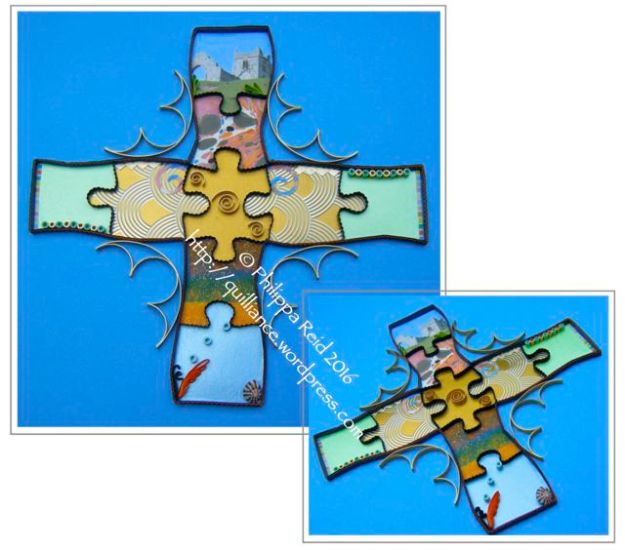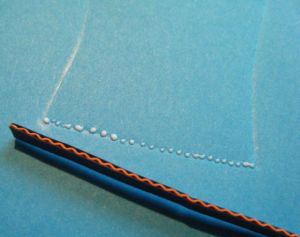So, this is the style that I’m adopting for my gallery collection: a segmented collage of different background papers, individually bordered with black crimped paper strip ‘leading’ like the panes of a stained glass window – all contained within a rigid framework made from ‘sandwiched’ multiple quilling strips and selectively decorated with various forms of paper filigree. Continuing the stained glass window analogy, each piece is going to be framed by tracery shapes, constructed from metallic-edged quilling strips. In church architecture, tracery forms an integral part of the window, crossing the panes, whereas mine positions itself – perversely! – around the edges.
If art provides an insight into a person’s soul, this speaks volumes about my affinity with bold shapes, ideas and colours. I’m so excited that others have seen and responded positively to this unique new style of mine … and I feel as though my creativity has been unleashed in a way that I’ve really never experienced before.
Yes, it’s moving away from quilling just a bit … well, away from ‘traditional quilling’, anyway, and for that reason I suspect it may not necessarily find favour with all of my friends and acquaintances in the ‘quilling blogosphere’. However, quilling still underpins the work in so many different ways: in the tracery (ring coils, cut and joined); in the edging (straight and crimped quilling strips sandwiched together); in the decorative detail of the window panes (open coils, ring coils and delicate huskings – the very essence of filigree as practised by our ancestors).
Because the piece shown above speaks for my soul, it had to contain just a little bit of Somerset. You’ll find this in the uppermost segment: a tiny image showing the summit of Burrow Mump – an iconic hill which rises dramatically out of the flat lands of the Somerset Levels.
King Alfred the Great is known to have climbed Burrow Mump to scan the distant landscape for marauding Danes in ancient times. During the time of his reign as the King of Wessex, the area of the Somerset Levels was a vast, marshy sea in which this natural knoll stood out as an island, making it an ideal lookout post. The ruin at the top of the Mump is the medieval church of St Michael which was used as a refuge by Royalist soldiers during the Civil War. Soon afterwards, the King’s army occupied it again during the Monmouth Rebellion of 1685. The views from the summit of Burrow Mump are spectacular to say the least. As you catch your breath beside the ruined church after your steep climb, you can look out towards other ‘islands’ standing in the Levels, such as Glastonbury Tor and Alfred’s own royal Isle of Athelney. The Rivers Parrett and Tone converge at the foot of the Mump and flow away together to the Bristol Channel. It’s a truly magical place.
When creating this piece, I imagined that there might be gold deep inside the Mump, stretching out beneath the strata of the rock. Go deep enough down, and you might eventually discover subterranean water, whose colour echoes the brilliant blue of the sky above. However, I will leave my image of the Mump to speak to you in its own way …
For those who are interested in the technicalities of these things, I created the outline for this collage using a cross formation assembled using blank jigsaw pieces, which then provided templates for the individual segments of the design. The borders of the cross are delineated using my quilling strip ‘sandwich’ technique , glued down on to an outline shape which I embossed on to the blue background card over mounting board, using the crooked end of a crochet hook. In this photo, you can see how I applied tiny dots of glue into the indented outline and allowed them to go ‘tacky’ for a minute or so before placing the ‘sandwiched’ strip into position on the background card:
I am proud of this piece, which will be placed on public display at various locations in the coming months, unless previously sold. Should you be interested in purchasing it (or maybe even something similar, custom-made), please contact me by emailing quilliancemail@gmail.com or leave a comment below.



I love that you are doing different things with your quilling Philippa. The ‘is it quilling’ point was just brought up recently on the ‘Quilling Plus’ page and Roxanne advised that a piece can only be called quilling if it has the ‘allowed’ shapes in it that the Guilds use (so yours would qualify as a quilled piece). I particularly liked her point about maybe we should differentiate between quilling and paper filigree. This conversation was brought up because of the way a lot of so called quilled pieces are basically just curved or straight lines (like a lot of the Chinese Quilling). I think it would make a good discussion point for the Guilds. I love the tip you gave too about ’embossing’ your outline, I would never have thought of that… brilliant idea!
LikeLike
Thanks Margaret – I can see that you’re like me: an adventurous quiller at heart! I’ve been following the conversation that you mention in the Quilling Plus group, and it does raise some interesting issues which are definitely worthy of discussion … However, it seems to me that the projects we’re all working on are constantly evolving, so maybe there’s a point at which we just have to stop trying to define what we’re doing and simply call it ‘Art’! I really appreciate your interest in my work. Thanks again, Philippa
LikeLike
My comment is almost the same as Margaret Jones, Philippa, It is always exciting to see how quilling is evolving!!! And for me, it has always been and always will be ART.
LikeLike
I always value your opinion, Sheila, and I know that you are right! Thank you.
LikeLike
Congratulations for this very inspiring work with a beautiful story.
LikeLike
Thank you Pily!
LikeLiked by 1 person